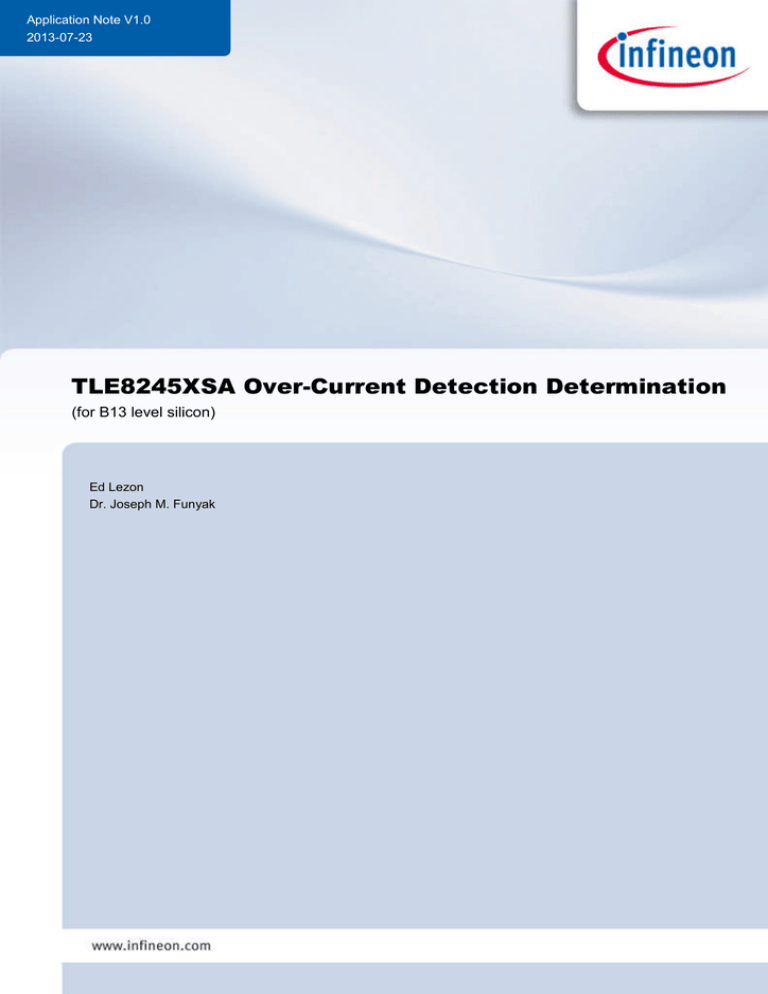
Application Note V1.0
2013-07-23
TLE8245XSA Over-Current Detection Determination
(for B13 level silicon)
Ed Lezon
Dr. Joseph M. Funyak
Design Note AN 2013-XX
2013-01
Dragon IC OVC Determination
V1.0 July 23, 2013
Edition 2011-02-02
Published by
Infineon Technologies NA
Livonia, MI USA
© Infineon Technologies AG 2011.
All Rights Reserved.
Attention please!
THE INFORMATION GIVEN IN THIS APPLICATION NOTE IS GIVEN AS A HINT FOR THE IMPLEMENTATION OF THE INFINEON TECHNOLOGIES COMPONENT ONLY AND SHALL NOT BE REGARDED
AS ANY DESCRIPTION OR WARRANTY OF A CERTAIN FUNCTIONALITY, CONDITION OR QUALITY
OF THE INFINEON TECHNOLOGIES COMPONENT. THE RECIPIENT OF THIS APPLICATION NOTE
MUST VERIFY ANY FUNCTION DESCRIBED HEREIN IN THE REAL APPLICATION. INFINEON
TECHNOLOGIES HEREBY DISCLAIMS ANY AND ALL WARRANTIES AND LIABILITIES OF ANY KIND
(INCLUDING WITHOUT LIMITATION WARRANTIES OF NON-INFRINGEMENT OF INTELLECTUAL
PROPERTY RIGHTS OF ANY THIRD PARTY) WITH RESPECT TO ANY AND ALL INFORMATION
GIVEN IN THIS APPLICATION NOTE.
Information
For further information on technology, delivery terms and conditions and prices please contact your
nearest Infineon Technologies Office (www.infineon.com).
Warnings
Due to technical requirements components may contain dangerous substances. For information on the
types in question please contact your nearest Infineon Technologies Office. Infineon Technologies
Components may only be used in life-support devices or systems with the express written approval of
Infineon Technologies, if a failure of such components can reasonably be expected to cause the failure of
that life-support device or system, or to affect the safety or effectiveness of that device or system. Life
support devices or systems are intended to be implanted in the human body, or to support and/or maintain
and sustain and/or protect human life. If they fail, it is reasonable to assume that the health of the user or
other persons may be endangered.
Revision History: 2013-07-23, V1.0
Previous Version: none
Subjects: Short-to-Battery or Short-to-Ground Detection Method
Authors:
Ed Lezon (IFNA ATV SMD AMR M PEV)
Dr. Joseph M. Funyak (IFNA ATV SMD AMR M PEV)
We Listen to Your Comments
Any information within this document that you feel is wrong, unclear or missing at all? Your feedback will
help us to continuously improve the quality of this document. Please send your proposal (including a
reference to this document) to: [ed.lezon@infineon.com]
2
Design Note AN 2013-XX
2013-01
Dragon IC OVC Determination
V1.0 July 23, 2013
Table of contents
1 Introduction..................................................................................................................................................4
2 Dragon IC Over-Current Detection Overview ...........................................................................................4
3 Determining a True OVC Fault ...................................................................................................................5
4 References ...................................................................................................................................................7
3
Design Note AN 2013-XX
2013-01
Dragon IC OVC Determination
1
V1.0 July 23, 2013
Introduction
The following narrative is an explanation of how the Over-Current (OVC) detection process
works in the TLE8245xSA, Dragon Integrated Circuit (IC), as specified in Data Sheet
TLE82453_ds_10 for B13 level silicon [1]. An OVC condition occurs when an unexpected
high current flows through one or more of the output channels of the Dragon IC due to a
short to the battery condition when in a low-side configuration or a short to ground
condition when in a high-side configuration. The Dragon IC is designed so that current
spikes or fast intermittent shorts will not cause an unwanted diagnostic flag setting and
subsequent halting of the Dragon IC operation. The operation is similar to a deglitching
filter. An important point is that the primary operational objective of the Dragon is to
provide the exact current requested by the system software. This means the Dragon was
designed to attempt to supply the set point current regardless of system disturbances.
2
Dragon IC Over-Current Detection Overview
Figure 2.1: Dragon Over-Current Detection
Figure 2.1 above is used to illustrate the diagnostic feature. The following is a description
of the various parts of the figure:
Line A, the red line: represents the output current of the Dragon IC
Line B, the yellow line: represents the OVC detection threshold of the
Dragon IC
Line C, the purple line: represents an OVC is present from the OVC detector
logic
Line D, the black line: represents the Pulse Width Modulation (PWM)
controller output to the output stage
Region T1, light red: Starts at the beginning of a PWM period (time point t1),
after a short time the OVC logic turns off the output at time point t3
4
Design Note AN 2013-XX
2013-01
Dragon IC OVC Determination
V1.0 July 23, 2013
Region T2, light yellow: time required for the OVC logic to initiate the OVC
timer window (T3), turn on the output stage (t5) and the start of an OVC
condition at time point t6
Region T3, light orange: OVC detection timer window approximately 10us
required
For Figure 2.1, we will assume the Dragon is set up in a low-side configuration and there
is an actual short from one of the outputs of the Dragon IC to the battery line of the
module. The Dragon is commanded to deliver a current (determined by whatever is
commanded by the software through the SPI communication line) while the output of the
Dragon IC is in a short circuit condition. Line A, the red line, represents the output current
of the Dragon IC. It can be seen on the far left of Figure 2.1 prior to Region T1 that Line A
(channel output current) is coming down from the previous Pulse Width Modulation (PWM)
cycle. Time point t1 is the start of the next PWM cycle as indicated by the rise of Line D,
the black line, of the PWM control loop. Since there is an actual shorted condition, Line A
shows that high current immediately starts to flow through the Dragon IC and rises above
the OVC Threshold level (Line B, the yellow line) at time point t2. The Dragon IC
recognizes the rise of the output current above the OVC Threshold at time point t2 as a
possible shorted condition and shuts the output transistor off after a short period of time as
indicated at time point t3.
In Region T2, the output current, Line A, falls below the OVC Threshold at time point t4.
This results in no additional actions. At time point t5 the OVC timer window is ready to
measure and the output transistor is turned on (internal chip function). If the output current
rises again above the OVC Threshold as indicated at time point t6 in region T3 of Figure
2.1, the Dragon IC starts the OVC detection timer window indicated by the rising edge of
Line C as represented in region T3 of Figure 2.1. The length of time of region T3 is
approximately 10 microseconds. As the output current, Line A, rises above the OVC
Threshold level (Line B), the Dragon IC goes into a self protection mode by limiting the
output current to a level just above the OVC Threshold level as illustrated at time point t7.
The output current is allowed to stay higher than the OVC Threshold level so that the
internal OVC detection feature can determine if a true short circuit condition exists while
keeping the current at a level that does not cause damage to the Dragon IC.
The final part of the OVC detection feature is the setting of the OVC fault flag. An OVC
fault flag is set if the output current, Line A, stays above the OVC Threshold level, Line B,
for approximately ten microseconds (time point t9).
3
Determining a True OVC Fault
There is a possibility that an OVC fault flag may not be set when a true short circuit
condition occurs. This may occur when the PWM “on” cycle, Line D, turns off at time point
t8 (less than 10 microseconds) before the OVC detection timer window T3 is completed
(approximately ten microseconds) causing the output current, Line A, to fall below the
OVC Threshold level (Line B). This possibility can occur when there is a true short circuit
5
Design Note AN 2013-XX
2013-01
Dragon IC OVC Determination
V1.0 July 23, 2013
condition, set point currents are low, and the PWM frequency is high. As mentioned
earlier in this discussion, the primary objective of the Dragon is to deliver very accurate
average current to the load. The Dragon will internally adjust the parameters it has control
of in order to try to maintain this very accurate average current. This includes modifying
the PWM frequency in order to maintain the accurate average current. For example, if the
set point current is 50mA and there is a short circuit condition, the 50mA average current
may be obtained with only a fraction of the programmed PWM cycle or said in a different
way, the average output current is reached with a smaller than expected duty cycle. In this
example, the on time required is less than 10 microseconds. This means the Dragon will
internally change the PWM frequency so that the PWM “on” time is shorter than the OVC
detection window timer (~ten microseconds). This would result in the Dragon IC
continuously repeating the OVC detection feature without setting an OVC fault flag if a true
shorted condition is present for low set point currents. Figure 3.1 provides a graphical
representation of the calculated minimum set point currents at the associated programmed
PWM frequency and System Clock Frequency (Fsys) that may result in the Dragon IC not
recording an OVC fault flag in a short circuit condition.
Figure 3.1: Dragon Minimum Set-Point Current for OVC Fault Flag Detection
It can be seen from Figure 3.1 that the minimum set point current that the Dragon IC will
reliably set a fault flag in a short circuit condition when the Fsys clock equals 4MHz falls
along or above the BLUE line and for the Fsys clock equal to 6MHz the along or above the
RED line. As an example, for IC parameters set so the Fsys clock equals to 4MHz and
PWM frequency 2.5KHz, the Dragon IC may not be able to consistently set the OVC fault
flag for current set points less than 80mA. Any current set points above 80mA for these
same IC settings the Dragon IC will reliably set a fault flag if a short condition exists.
6
Design Note AN 2013-XX
2013-01
Dragon IC OVC Determination
V1.0 July 23, 2013
Likewise, if the IC parameters are set such that Fsys is equal to 6MHz and the PWM
frequency 2.5KHz, the minimum set point current is approximately 62mA. The Dragon IC
may not consistently set a fault flag for a true shorted condition for current set points below
62mA but will consistently set a fault flag in a shorted condition for current set points
above 62mA with Fsys equal to 6MHz and PWM equal to 2.5KHz. Therefore, the Dragon
IC may not reliably set a fault flag in a short circuit condition for current set points under
the BLUE line for the associated PWM frequency with Fsys equal to 4MHz and current set
points under the RED line for the associated PWM frequency with Fsys equal to 6MHz.
A method to determine if a true short circuit condition exists (when operating the Dragon
IC below the RED or BLUE line as depicted in Figure 3.1) is to monitor the MIN/MAX
current feedback register. The MIN/MAX current feedback register will provide the
maximum current and the minimum current within the switching envelope as the IC is
operating. Therefore a rough average output current of the IC can be determined by
adding the peak current reading and the minimum current reading, then divide by two.
Ideally, in a non-short circuit condition, this calculated average current should be close to
the commanded set-point current. For this test procedure for set-point currents that are
relatively low (below 120mA for PWM frequency equal to 4kHz and Fsys equal to 4MHz), if
the calculated average current is above 400mA, then there is a very high probability that a
true short circuit condition exists.
4
References
[1]
Infineon Technologies AG: TLE82453_ds_10, TLE82453SA 3 Channel High-Side and Low-Side
Linear Solenoid Driver IC, V1.0, April 10, 2013.
7



